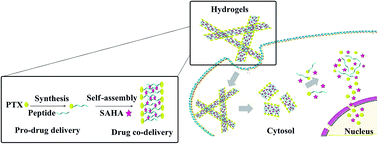Paclitaxel (PTX) is among the most widely used chemotherapeutic agents in clinical settings. The drug imposes its anticancer effect by preventing cell division. Cancer cells learn to resist PTX over time by various mechanisms including creating alterations in the protein targeted by PTX and rewiring of cell survival pathways to evade cell death.
Clinicians combine PTX with suberoylanilide hydroxamic acid (SAHA) to suppress cancer drug resistance and improve treatment outcome. The benefits of combination therapy include improved accumulation of the drug at cancer sites, the ability to trigger cell death by complementary or synergistic mechanisms and longer retention of the drug within patients. Given the strong rationale for combination therapies, Shu and colleagues at the Department of Pharmaceutical Analysis, Key Laboratory on Protein Chemistry and Structural Biology, China developed a novel peptide hydrogel which encapsulates PTX and SAHA within a single co-delivery nano-carrier.

The study found that the Nap-PTX-SAHA hydrogels could be injected at room temperature into test mice, suggesting that no specialized equipment or storage conditions were necessary to administer the drug. The study also found that SAHA is released more readily than PTX from Nap-PTX-SAHA hydrogels. This could mean that cancer cells will be exposed to the two chemotherapy agents at different times, allowing for a one-two punch based tumor killing strategy.
When administered to tumor-bearing mice, the Nap-PTX-SAHA regimen was found to decrease tumor volume up to 2-fold compared to mice treated traditionally with PTX or SAHA alone. Interestingly, the researchers also noted that Nap-PTX-SAHA was associated with fewer side effects, as evidenced by normal eating behavior and weight in test mice. Interestingly, Nap-PTX-SAHA was absorbed lesser in non-target organs such as the heart, spleen and kidneys.
On the basis of these promising preclinical studies, the authors propose that Nap-PTX-SAHA represents a promising candidate for clinical trials in the years to come.
Read the full article here:










